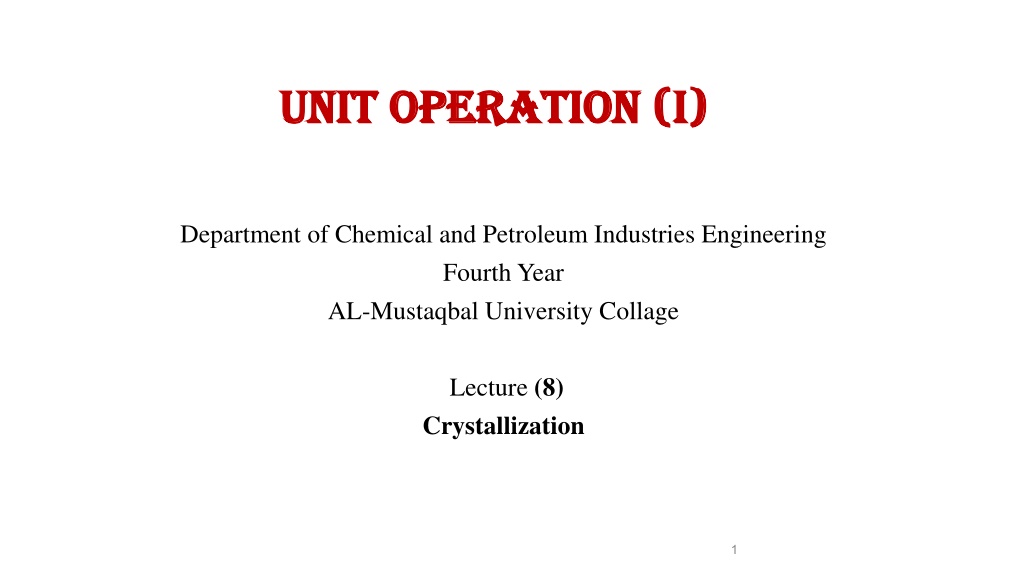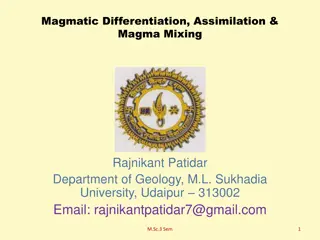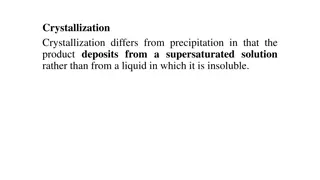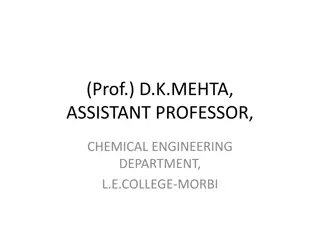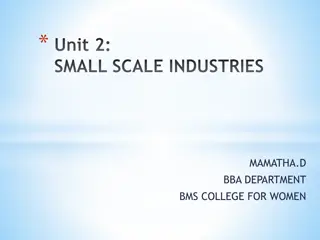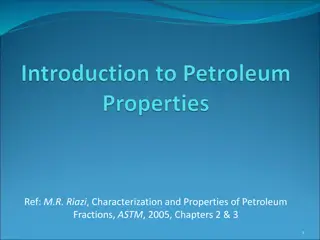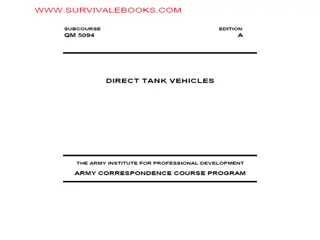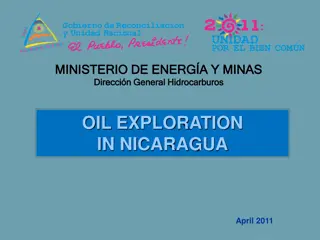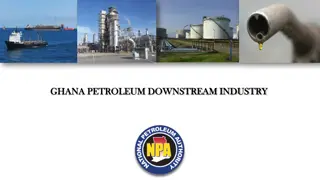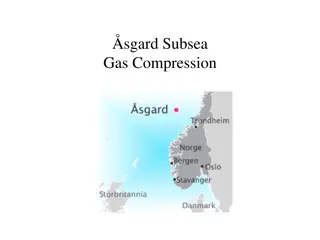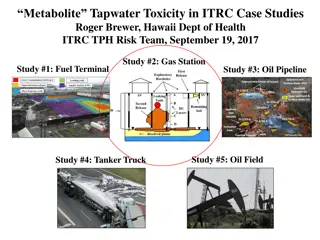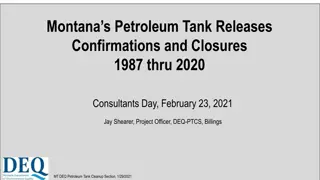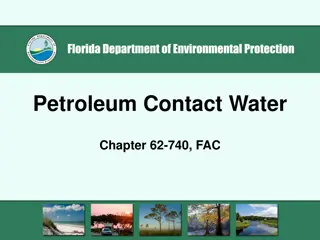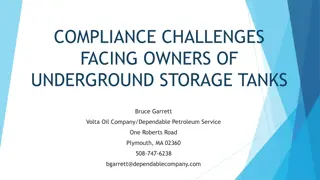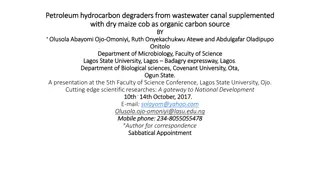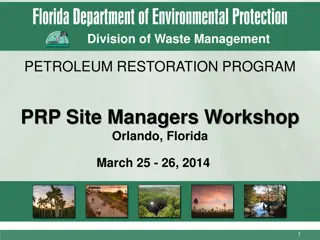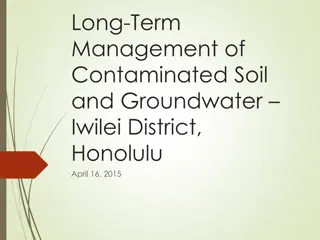Crystallization Process in Chemical and Petroleum Industries
Crystallization is a purification method used in industries to produce crystalline materials like sugar and citric acid. It involves nucleation and crystal growth stages. Key terms include nucleation, solubility, and supersaturation, impacting crystal formation. Various methods like cooling, evaporation, and vacuum can induce supersaturation in batch crystallizers. Understanding stable, metastable, and labile regions in the process is crucial for efficient crystallization.
Download Presentation

Please find below an Image/Link to download the presentation.
The content on the website is provided AS IS for your information and personal use only. It may not be sold, licensed, or shared on other websites without obtaining consent from the author. Download presentation by click this link. If you encounter any issues during the download, it is possible that the publisher has removed the file from their server.
E N D
Presentation Transcript
Unit operation (I) Unit operation (I) Department of Chemical and Petroleum Industries Engineering Fourth Year AL-Mustaqbal University Collage Lecture (8) Crystallization 1
Crystallization Crystallization It is a method of purification and a method of providing crystalline materials in the desired size range. e.g. production of crystalline sugar, citric acid and in biotechnological operations such as the processing of proteins. The crystallization process consists of two stages: 1st the formation of small particles or nuclei, 2ndthe growth of nuclei. Glossary: Crystallizer: the vessel or process unit in which crystallization occurs. Growth: the increase in crystal size due to deposition of solute on crystal surfaces. Mother liquor: the liquid solution from which crystals are formed. Magma: the mixture of crystals and mother liquor in the crystallizer. Mode of crystallization: the means by which a thermodynamic driving force for crystallization is created. MSMPR (mixed-suspension, mixed-product-removal) Crystallizer: a vessel operating in a continuous manner in which crystallization occurs and whose contents are perfectly mixed. As a result of perfect mixing, all variables (temp., conc., velocity, turbulence, etc) descriptive of the mother liquor and crystals are constant throughout the vessel and are identical to corresponding variables in the product stream leaving the vessel. 2
Nucleation: the formation of new crystals. Solubility (Saturation): It is the maximum concentration of solute which is thermodynamically stable in solution. Supersaturation: is called on the solution when containing solute more than that of saturation. It is the difference between existing and equilibrium conditions; the quantity represents the driving force for crystal nucleation and growth. Concen.-Temp. relation for saturated solution Curve 1 is the solubility curve, curve 2 is the limit of the metastable region in which the nucleation rate is very low. If a solution at A is cooled without loss of solvent along ABC, Supersaturation is achieved, spontaneous nucleation cannot occur until C is reached. Supersaturation is achieved by removing solvent and ADE represents such an operation carried out at constant temp or Supersaturation can be achieved by vacuum on line AFG 3
There are three regions: 1- Stable- under saturated- crystal present will dissolve. 2- Metastable-a supersaturated region in which crystals will grow. 3- Labile- a region in which a solution will nucleate spontaneously. The degree of supersaturation (absolute supersaturation) is c = c c * , c is the driving force, c is solution concentration and c * is the Eqlm. saturated value. The supersaturation ratio, S,: S = c/c* and the relative supersaturation; = c/c* = S 1 (= , change in chemical potential) In batch crystallizer, supersaturation can be generated in several ways, either solely or combination: 1. Cooling 2. Evaporation 3. Precipitation 4. Vacuum 4
Ex.1: If sodium chloride solution, at temperature of 40 C, has a concentration of 50% when the solubility of sodium chloride at this temperature is 36.6g/100g water, calculate the quantity of sodium chloride crystals that will form once crystallization has started. Solution: Weight of salt in solution = 50 gm salt/100 gm solution = 50 gm salt/50 gm water = 100 gm salt/100 gm water Saturation solution = 36.6 g salt/100g water Weight crystallized out = 63.4 salt/100g water To remove more salt, this solution would have to be concentrated by removal of water, or else cooled to a lower temperature. 5
Ex.2: At 293 K, a supersaturated solution of sucrose contains 2.45 kg sucrose/kg water. If the equilibrium saturation value is 2.04 kg/kg water, what is the supersaturation ratio in terms of kg/kg water and kg/kg solution? Solution: For concentrations in kg sucrose/kg water: c = 2.45 kg/kg, c* = 2.04 kg/kg S = c/c* = (2.45 / 2.04 ) = 1.20 And for concentrations in kg sucrose/kg solution: c = 2.45 / (2.45 + 1.0) = 0.710 kg/kg solution c* = 2.04 / (2.04 + 1.0) = 0.671 kg/kg solution S = c/c* = (0.710 / 0.671 ) = 1.06 Heat Heat of of crystallization crystallization: When a solution is cooled to produce a supersaturated solution and hence to cause crystallization, the heat that must be removed is the sum of the sensible heat necessary to cool the solution and the heat of crystallization. The heat of crystallization is the opposite of heat of solution. 6
Ex.1: Lactose syrup is concentrated to 8g lactose per 10g of water and then run into crystallizing vat which contains 2500 kg of the syrup. In this vat, containing 2500 kg syrup, it is cooled from 57 C to 10 C. lactose crystallize with one molecule of crystallization water. The specific heat of lactose solution is 3470 kj /kg C. the heat of solution for lactose monohydrate is -15.500 kj /kmole. The molecular weight of lactose monohydrate is 360 and the solubility of lactose at 10 C is 1.5g/10g water. Assume that 1% of the water evaporates and that the heat loss through the vat walls is 4 10 4 kj. Calculate the heat to be removed in the cooling process. Solution: Heat Balance: Heat lost from solution = Heat removed Sensible at lost from solution when cooled from 57 C to 10 C + Heat of crystallization = Heat lost through walls + Latent heat of evaporation + Heat removed by cooling Sensible at lost from solution when cooled from 57 C to 10 C = m CP T = 2500 3.47 47 = 40.8 10 4 kj 7
Heat of crystallization = (reverse of heat of solution) = 15500 kj/kmol = 15500/360 = 43.1 kj/kg Solubility of lactose at 10 C = 1.5g/10g water; Anhydrous lactose crystallized out = 8 - 1.5 = 6.5g/10g water Hydrated lactose crystallized = 6.5 (342 +18)/342 = 6.8g/10g water Total water = 10 2500/18 = 1390 kg Total Hydrated lactose crystallized out = 6.8 1390/10 = 945 kg Total heat of crystallization = 945 43.1 = 4.07 10 4 kj Heat removed from solution: Heat removed by vat wall = 4 10 4 kj Water evaporated = 1% = 13.9 kg The latent heat of evaporation (from steam table) = 2422.4 kj/kg (at mean temp =33.5 C) Heat removed by evaporation = 13.9 2422.4 = 3.367 10 4 kj So, from Heat Balance: 40.8 10 4 + 4.07 10 4 = 4 10 4 + 3.367 10 4 + Heat removed by cooling Heat removed by cooling = 37.5 10 4 kj 8
Nucleation: It can result from several mechanisms: Homogeneous nucleation: is the form of crystals from the liquid phase as a result of supersaturation only. Heterogeneous nucleation: results from the presence of insoluble material which initiate crystal growth. Secondary nucleation: including nucleation induced by the contact between different crystals. Attrition: is simply the breakup of existing crystals into new particles which grow. Nucleation Rate: dN/ dt = kn (c - c* ) i = B .(2) c = concentration in solution c *= concentration at saturation kn , i = are empirical parameters which depend both on the specific solute and on physical aspects like stirring B = nucleation rate itself 9
Crystallization Rate : since the resistance to heat and mass transfer lies predominantly in the laminar sub-layer close to the surface of the crystal, the rate of growth of the crystal is improved by increasing the relative velocity between the solid and the liquid. The rate of crystallization is a function of the degree of supersaturation. For crystallization from a melt the process is dependent on the rate of heat between the crystal face and the surrounding. 10
Growth rate: Because the rate of growth depends on temperature, Supersaturation, size, habit of system, turbulence and so on, there is no simple way of expressing the rate of crystal growth, although, under defined conditions, growth may be expressed as: an overall mass deposition rate, RG (kg/m2 s), an overall linear growth rate Gd [=dl/dt] (m/s) or as a mean linear velocity, u/ [=dr/dt] (m/s). Here l is some characteristic size of the crystal, and r is the radius = 0.5 l. For non-agitated systems, the growth rate (dM /dt ) is limited by diffusion (diffusion control): dM /dt = kA (c - c* ) .(3) Where: k = mass transfer coefficient, A = crystal area 11
With agitation; growth rate is consistent with diffusion control at small relative velocities and reaction control at high relative velocities: ? dM /dt = (c - c* ) (4) 1 ?+ 1 ?? Where: kr = surface reaction rate constant Note: k varies with solution properties like viscosity and agitation, but kr dose not. k varies little with temperature, but kr can change dramatically on cooling. Mass of crystal: M = vl3 and surface area of crystal: A = 6 Al2 (for cubic crystal) Where: is shape factor ? And dM /dt = 3 vl2 dl /dt = { }(c - c* ) 1 ?+ 1 ?? dl /dt = {2 A / v }(c - c* ) 1 ?+ 1 ?? = kg (c - c* ) = G Where: kg = {2 A / v } = rate constant for single crystal growth, and G = growth rate 1 ?+ 1 ?? 12
Crystal yield: The yield of crystals produced by a given degree of cooling may be estimated from the concentration of the initial solution and the solubility at the final temperature C1 C2 ( 1 E) 1 C2(?1 1) y = R1 1 Where: y = yield of crystals, 1 = initial mass of solvent in the liquor R1 = ratio (molecular mass of hydrate/molecular mass of anhydrous salt) c1 = initial concentration of solute, c2 = the final concentration of solute E = ratio (mass of solvent evaporated/mass of solvent in the initial solution) The quantity E must be estimated, where, from a heat balance: E = ? ?1 ?1 ?2 +?? ?1 ?2 1 ?2 ?1 1 ? ?1 ?2 1+?1 [ 1 ?2 ?1 1 ] = latent heat of evaporation of the solvent (J/kg) q = heat of crystallization of the product (J/kg) T1 = initial temperature of the solution (K) T2 = final temperature of the solution (K) Cp = specific heat capacity of the solution (J/kg K). 13
Ex: What is the theoretical yield of crystals which may be obtained by cooling a solution containing 1000 kg of sodium sulphate (molecular mass = 142 kg/kmol) in 5000 kg water to 283 K? The solubility of sodium sulphate at 283 K is 9 kg anhydrous salt/100 kg water and the deposited crystals will consist of the deca-hydrate (molecular mass = 322 kg/kmol). It may be assumed that 2 per cent of the water will be lost by evaporation during cooling Solution: yield of crystals: y = R1 1C1 C2 ( 1 E) 1 C2( R1 1) R1 = (322/142) = 2.27 Initial concentration, c1 = (1000/5000) = 0.2 kg Na2SO4/kg water final concentration (solubility) c2 = (9/100) = 0.09 kg Na2SO4/kg water Initial mass of water, 1 = 5000 kg and the water lost by evaporation, E = (2/100) = 0.02 kg/kg : y = 2.27 5000 0.2 0.09 ( 1 0) 1 0.09(2.27 1) = 1432 kg Na2SO4.10H2O Ex: If sodium chloride solution, at a temperature of 40 C, has a concentration of 50% when the solubility of sodium chloride at this temperature is 36.6g / 100g water, calculate the quantity 0f sodium chloride crystals that will form once crystallization has started Solution: y = R1 1C1 C2 ( 1 E) 1 C2( R1 1) = 1 100 1 0.366 ( 1 0) 1 0.366 ( 1 1) = 63.4 NaCl crystallize/100 g water 14
Ex. Concentrate from an evaporation system is 4,466 lb/h of 37.75 wt% MgSO4 at 170 F and 20 psia. It is mixed with 9,860 lb/h of a saturated aqueous recycle filtrate of MgSO4 at 85 F and 20 psia and sent to a vacuum crystallizer, operating at 85 F and 0.58 psia, to produce water vapor and a magma of 20.8 wt% crystals and 79.2 wt% saturated solution. The magma is sent to a filter, from which filtrate is recycled. Determine the lb/h of water evaporated and the maximum crystal production rate in tons/day on a dry basis. 15
Solution: For saturated filtrate at 85 F, the wt% of MgSO4, from Figure A, is 0.28. Therefore, MgSO4 in the recycle filtrate is 9860(0.28) = 2760 lb/h. By mass balance around the mixing step 16
The crystallizer mass balance is made on MgSO4. At 85F, from Figure A, 28 wt% aqueous MgSO4 liquid. Because the MW of MgSO4 (120.4) and MgSO4.7H2O (246.4), the crystals are 120.4/246.4 = 0.4886 mass fraction MgSO4 By a MgSO4 balance; 4446 = 0.28L + 0.4886S (1) Where L = lb/h of liquid and S = lb/h of crystals Also; S = 0.208M = 0.208(S + L) (2) [M is the magma] Solving (1) and (2) simultaneously L = 10889 lb/h and S = 2856 lb/h and M = S + L = 13745 By a total material balance around the crystallizer, F = V + L + S Where F = total feed rate and V = evaporation rate. Therefore 14326 = V + 10889 + 2856 V = 581 lb/h The maximum production rate of crystals is = M Recy = 13745 9860 = 3885 lb/hr OR from O.M.B.: 4466 581 = 3885 lb/hr = (3885/2200)(24) = 42.38 tons/day 17
Crystallizers: crystallizers are usually classified according to the method by which supersaturation is achieved, that is by cooling, evaporation, vacuum, reaction and salting out 1. Cooling crystallizers Non-agitated vessels: The simplest type of cooling crystallizers is an unstirred tank in which a hot feedstock solution is charged to an open vessel and allowed to cool, often for several days. Agitated vessels: Installation of an agitator in an open-tank crystallizer gives smaller and more uniform crystals and reduces batch times. 18
2. Evaporating crystallizers: If the solubility of a solute in a solvent is not appreciably decreased by lowering the temperature, the appropriate degree of solution supersaturation can be achieved by evaporating some of the solvent and the oldest and it is simplest technique, the use of solar energy, is still employed commercially throughout the world. 3. Vacuum (adiabatic cooing) crystallizers: A vacuum crystallizer operates on a slightly different principle from the reduced- pressure unit since supersaturation is achieved by simultaneous evaporation and adiabatic cooling of the feedstock. 4. Continuous crystallizers: The majority of continuously operated crystallizers are of three basic types: forced-circulation, fluidized-bed and draft-tube agitated units. 19
